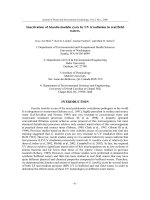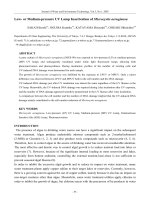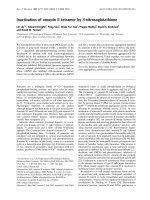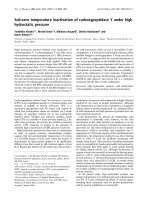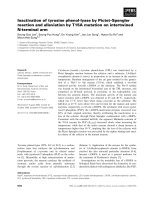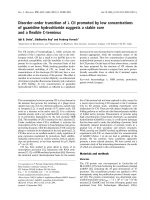- Trang chủ >>
- Khoa Học Tự Nhiên >>
- Vật lý
Inactivation of gram negative bacteria by low pressure RF remote plasma excited in n2 o2 mixture and SF6 gases
Bạn đang xem bản rút gọn của tài liệu. Xem và tải ngay bản đầy đủ của tài liệu tại đây (333.9 KB, 5 trang )
Iran J Med Sci December 2013; Vol 38 No 4
IJMS
Vol 38, No 4, December 2013
334
Inactivation of Gram-Negative Bacteria by Low-
Pressure RF Remote Plasma Excited in N
2
-O
2
Mixture and SF
6
Gases
Ayman Al-Mariri
1
, PhD; Saker Saloum
2
,
PhD; Omar Mrad
3
, PhD;
Ghayath
Swied
1
, MD; Bashar Alkhaled
2
, MD
Introduction
The objective of the low-pressure plasma process is to control
the generation of ions, electrons, and free radicals on a surface in
order to modify its property. This process is now deemed a new
attractive method in the eld of sterilizing medical instruments.
1
A low-pressure, 13.56-MHz hollow cathode discharge is a very
attractive device for the process and synthesis of remote plasma-
aided materials.
2,3
Infections acquired in hospitals claim the life of one
patient every 6 minutes. Escherichia, Klebsiella, Proteus, and
Enterobacter species are the most common bacterial isolates that
cause nosocomial infections,
4,5
the treatment of which is severely
hampered by antibiotic resistance.
4
To overcome this, a great deal
of research has been carried out on the effect of stresses such
as cold shock, UV irradiation,
6
and ozone on various bacteria
7
and spores
6
and the results have shown that exposure to such
stresses bring about changes in the cell structure of these
microorganisms. O
2
-N
2
plasma mixture is a good example of
such applications in that it is an efcient source of both N and O
atoms (chemically reactive species) and of UV radiation emitted
by NO-excited molecules.
8
We sought to study the inactivation potency of plasma
treatment by using O
2
-N
2
and SF
6
gases against local E. coli
O157, K. pneumonia, P. mirabilis, and E. sakazakii bacterial
isolates.
1
Department of Molecular Biology
and Biotechnology, Atomic Energy
Commission of Syria, Damascus, Syria;
2
Department of Physics, Atomic Energy
Commission of Syria, Damascus, Syria;
3
Department of Chemistry, Atomic
Energy Commission of Syria, Damascus,
Syria
Correspondence:
Ayman Al-Mariri, PhD;
Department of Molecular Biology and
Biotechnology,
Atomic Energy Commission,
Kafer Sousa, 17
th
April Ave.,
P.O. Box 6091, Damascus, Syria.
Tel: +963 11 213580
Fax: +963 11 6112 289
Email: ascienti
Received: 30 May 2012
Revised: 12 September 2012
Accepted: 21 October 2012
Abstract
The role of low-pressure RF plasma in the inactivation of
Escherichia coli O157, Klebsiella pneumoniae, Proteus
mirabilis, and Enterobacter sakazakii using N
2
-O
2
and SF
6
gases was assessed. 1×10
9
colony-forming units (CFUs) of each
bacterial isolate were placed on three polymer foils. The effects
of pressure, power, distance from the source, and exposure
time to plasma gases were optimized. The best conditions to
inactivate the four bacteria were a 91%N
2
-9%O
2
mixture and a
30-minute exposure time. SF
6
gas was more efcient for all the
tested isolates in as much as the treatment time was reduced
to only three minutes. Therefore, low-pressure plasma could
be used to sterilize heat and/or moisture-sensitive medical
instruments.
Please cite this article as: Al-Mariri A, Saloum S, Mrad O, Swied Gh, Alkhaled B.
Inactivation of Gram-Negative Bacteria by Low-Pressure RF Remote Plasma
Excited in N
2
-O
2
Mixture and SF
6
Gases. Iran J Med Sci. 2013;38(4):334-338.
Keywords ● Bacteria ● Inactivation ● Low pressure ● Plasma ●
Polymer
Brief Report
335
Role of RF remote plasma in bacterial inactivation
Iran J Med Sci December 2013; Vol 38 No 4
Materials and Methods
Plasma System
The experimental set-up of the HCD-L 300
system was described in detail in our previous
works.
3,9
Tables 1 and 2 summarize the plasma
operation conditions using N
2
-O
2
mixture and
pure SF
6
gas, respectively.
Polymers
Polyethylene (PE), polyethylene terephthalate
(PET), and polyvinyl chloride (PVC) polymers,
commercially used for bio-application, were
provided as lms.
Micro-Organisms and Growth Conditions
Clinical local isolates were collected from
patients suffering from urinary tract infection
(E. coli O157
or P. mirabilis), upper respiratory
tract infection (K. pneumonia), or gastrointestinal
infection (E. sakazakii). Identication of the
bacteria was performed by using the API20E
method (bioMérieux, Charbonnieres-les-Bains,
France). The isolates were grown using standard
cultures (Difco, BD, Spars, MD), and the cultures
were harvested in a sterile PBS and adjusted by
spectrophotometry to 1.0×10
10
CFU/ml. Serial
dilutions of 100 µl (1.0×10
9
CFU/ml) of each
freshly grown isolate were placed either in 96-well
microtiter plates or on three sterilized polymer foils.
The plates and the foils were exposed to different
experimental plasma conditions (tables 1 and 2).
After treatment, the bacterial suspensions were
grown on bacterial mediums. The plates were
incubated for 24 hours at 37
°
C. All the experiments
were conrmed in duplicate. Reported values were
the average of each two values.
Statistical Methods
The statistical analyses were performed with
SPSS statistical program (version 15). A mean
value for each bacterial count was obtained
by averaging the duplicate values after log
conversion.
Results
The best conditions that led to the elimination of 10
9
CFU/ml of each tested bacterial isolate (using O
2
-N
2
plasma mixture at 300 W) are shown in gures 1, 2,
and 3. Figure 1 illustrates the inuence of plasma
pressure on bacterial count (exp. 1-6 in table 1).
Minimum CFU values were seen using 1.24 mbar
pressure. The effect of O
2
percentage (exp. 5,7, and
8 in table 1) in N
2
-x%O
2
plasma mixture is presented
in Figure 2: the CFU values of E. coli O157 were
Table 1: Experimental plasma conditions for the inactivation processes of 10
9
CFU/ml of different types of bacteria using N
2
-O
2
plasma mixture
Exp
x (%) in
N
2
-x% O
2
Gas ow N
2
/O
2
(sccm)
Pressure
(mbar)
Power
(W)
Treatment time
(min)
Z
(cm)
Substrate
1 9 500/50 0.35 300 30 4.5 96-well plate
2 9 500/50 0.65 300 30 4.5 96-well plate
3 9 500/50 0.95 300 30 4.5 96-well plate
4 9 500/50 1.17 300 30 4.5 96-well plate
5 9 500/50 1.24 300 30 4.5 96-well plate
6 9 500/50 1.48 300 30 4.5 96-well plate
7 5 500/26 1.25 300 30 4.5 96-well plate
8 2 500/10 1.25 300 30 4.5 96-well plate
9 9 500/50 1.25 300 5 4.5 96-well plate
10 9 500/50 1.25 300 10 4.5 96-well plate
11 9 500/50 1.25 300 15 4.5 96-well plate
12 9 500/50 1.25 300 20 4.5 96-well plate
13 9 500/50 1.25 300 25 4.5 96-well plate
14 9 500/50 1.25 300 40 4.5 96-well plate
15 9 500/50 1.25 300 30 4.5 PVC, PE, PET
Table 2: Experimental plasma conditions for the inactivation processes of different types of bacteria using pure SF
6
plasma
Gas ow
(sccm)
Pressure
(mbar)
Power
(W)
Treatment time
(min)
Z
(cm)
Substrate
1 200 0.55 100 0.5 4.5 96-well plate
2 200 0.55 100 1 4.5 96-well plate
3 200 0.55 100 3 4.5 96-well plate
4 200 0.55 100 5 4.5 96-well plate
5 200 0.55 100 10 4.5 96-well plate
6 200 0.55 100 15 4.5 96-well plate
336
Al-Mariri A, Saloum S, Mrad O, Swied Gh, Alkhaled B
Iran J Med Sci December 2013; Vol 38 No 4
decreased, while O
2
percentage was increased and
only 2% O
2
pressure was sufcient to completely
deactivate the other types of bacteria. The inuence
of the time of treatment (exp. 5 and 9-14 in table 1)
is demonstrated in gure 3. A 30-minute treatment
was required to eliminate all the different kinds of
microorganisms except E. coli O157, which was
decreased only to 2×10
2
CFU/ml. According to
these results, the best conditions were 4.5 cm
distance from the source, 30 minutes of treatment,
9% of O
2
, and 1.25 mbar pressure.
Using the above-mentioned conditions on
PVC, PE, and PET polymers (exp. 15 in table 1),
we observed total inactivation of all the tested
microorganisms with the PVC and PE polymers.
However, K. pneumonia was not inactivated when
we used PET polymer.
Figure 4 shows the effect of SF
6
plasma on
all the previously mentioned microorganisms,
using 96-well plates. Total inactivation of all the
tested bacteria was seen only 3 minutes after
the application of SF
6
. Approximately, 100% of
Figure 1: This is a depiction of the inuence of pressure change using O
2
-N
2
plasma mixture for 30 minutes against E. coli O15 7,
K. pneumonia, P. mirabilis, and E. sakazakii on the standard medium.
Figure 2: This is an illustration of the inuence of oxygen percentage using O
2
-N
2
plasma mixture for 30 minutes against E. coli
O15 7, K. pneumonia, P. mirabilis, and E. sakazakii on the standard medium.
337
Role of RF remote plasma in bacterial inactivation
Iran J Med Sci December 2013; Vol 38 No 4
all the P. mirabilis isolates were eliminated within
0.5 minute after SF
6
exposure and 100% of all
the E. coli O157 and Enterobacter isolates were
eliminated within one minute after SF
6
exposure.
However, about 80% of the K. pneumoniae isolates
were eliminated within one minute after exposure.
Discussion
Plasma treatment is considered a good and safe
method to eliminate the decontamination of not
only dental instruments but also general surgical
instruments.
10
Our results showed that the best
bacterial inactivation plasma conditions were 300
W applied power, 4.5 cm distance from the source,
and 1.24 mbar pressure at 9% of O
2
. Philip et al.
11
demonstrated that total inactivation of Bacillus
subtilis spores was achieved 40 minutes after plasma
exposure at 100 W with 2% of O
2
. Furthermore,
Xu et al.
1
reported that the time needed for the
Figure 3: This is a depiction of the inuence of the time of treatment using O
2
-N
2
plasma mixture at 1.24 mbar pressure against
E. coli O157, K. pneumonia, P. mirabilis, and E. sakazakii on the standard medium.
Figure 4: This is an illustration of the inuence of the treatment with SF
6
for one minute against E. coli O15 7, K. pneumonia, P.
mirabilis, and E. sakazakii on the standard medium.
338
Al-Mariri A, Saloum S, Mrad O, Swied Gh, Alkhaled B
Iran J Med Sci December 2013; Vol 38 No 4
inactivation of Geobacillus stearothermophilus
spores was 3 minutes. In another study, Xu et
al.
1
also found that 10-20% of O
2
was sufcient to
inactivate these bacteria. Elsewhere, Feichtinger et
al.
12
discovered that spores numbers were reduced
one second after the application of laboratory air as
plasma gas. Our results agree with those reported
by Xu et al.,
13
who revealed that using argon (Ar) in
a plasma jet source for 10 minutes did not totally
eliminate E. coli. According to our results, O
2
-N
2
gas
using a plasma source was able to totally inactivate
all kinds of bacteria except E. coli. The inactivation
effect was more pronounced when we used at
polymers as substrates. Ricard and Monna
14
reported that N
2
–5% O
2
gas mixture completely
eliminated Streptococcus mutans, Porphyromonas
gingivalis, and Prevotella intermedia bacteria 15–20
minutes after treatment. In contrast, our results
demonstrated that SF
6
gas totally inactivated the
bacteria in only 1-3 minutes.
Conclusion
Plasma inactivation using N
2
-O
2
gas mixture and
SF
6
gas proved promising for the inactivation of the
bacterial isolates in the present study. Our ndings
could be helpful in many medical and industrial
elds; however, further investigations are needed
to integrate this technique into the eld of bacteria
disinfection.
Acknowledgment
The authors would like to thank the Director General
of AECS, the Head of the Physics Department,
the Head of the Chemistry Department, and the
Head of the Molecular Biology and Biotechnology
Department for their support.
Conict of interest: None declared.
References
1 Xu L, Nonaka H, Zhou HY, Ogino A, Nagata
T, Koide T. Characteristics of surface-
wave plasma with air-simulated N
2
–O
2
gas
mixture for low-temperature sterilization.
J. Phys. D: Appl. 2007;40:803. doi:
10.1088/0022-3727/40/3/017.
2
Pointu AM, Ricard A, Dodet B, Odic E,
Larbre J, Ganciu M. Production of active
species in N
2
–O
2
owing post-discharges
at atmospheric pressure for sterilization.
J. Phys. D: Appl. 2005;38:1905. doi:
10.1088/0022-3727/38/12/009.
3
Saloum S, Naddaf M. Diagnostic study of low-
pressure Ar– O 2 remote plasma generated
in HCD-L 300 system: Relative density of O
atom. Vacuum. 2007;82:66-71. doi: 10.1016/j.
vacuum.2007.04.031.
4
Jones RN. Microbial etiologies of hospital-
acquired bacterial pneumonia and ventilator-
associated bacterial pneumonia. Clin Infect
Dis. 2010;51:S81-7. doi: 10.1086/653053.
PubMed PMID: 20597676.
5
Nielubowicz GR, Mobley HL. Host-pathogen
interactions in urinary tract infection. Nat
Rev Urol. 2010;7:430-41. doi: 10.1038/
nrurol.2010.101. PubMed PMID: 20647992.
6 Roleda MY, Hanelt D, Wiencke C. Exposure
to ultraviolet radiation delays photosynthetic
recovery in Arctic kelp zoospores. Photosynth
Res. 2006;88:311-22. doi: 10.1007/s11120-
006-9055-y. PubMed PMID: 16758269.
7
Patil S, Valdramidis VP, Cullen PJ, Frias J,
Bourke P. Inactivation of Escherichia coli by
ozone treatment of apple juice at different pH
levels. Food Microbiol. 2010;27:835-40. doi:
10.1016/j.fm.2010.05.002. PubMed PMID:
20 6 3 032 7.
8 Venezia RA, Orrico M, Houston E, Yin SM,
Naumova YY. Lethal activity of nonthermal
plasma sterilization against microorganisms.
Infect Control Hosp Epidemiol. 2008;29:430-
6. doi: 10.1086/588003. PubMed PMID:
18419365.
9
Saloum S, Naddaf M, Alkhaled B. Properties
of thin lms deposited from HMDSO/O2
induced remote plasma: effect of oxygen
fraction. Vacuum. 2008;82:742-7. doi:
10.1016/j.vacuum.2007.10.009.
10
Whittaker AG, Graham EM, Baxter RL,
Jones AC, Richardson PR, Meek G, et al.
Plasma cleaning of dental instruments. J
Hosp Infect. 2004;56:37-41. doi: 10.1016/j.
jhin.2003.09.019. PubMed PMID: 14706269.
11 Philip N, Saoudi B, Crevier MC, Moisan M,
Barbeau J, Pelletier J. The respective roles
of UV photons and oxygen atoms in plasma
sterilization at reduced gas pressure: the
case of N
2
-O
2
mixtures. IEEE Transaction
on Plasma Science. 2002;30:1429-36. doi:
10.1109/TPS.2002.804203.
12
Feichtinger J, Schulz A, Walker M,
Schuhmacher U. Sterilization with low-
pressure microwave plasmas. Surf Coat
Technol. 2003;175:564-9. doi: 10.1016/
S0257-8972(03)00404-3.
13
Xu L, Liu P, Zhan RJ, Wen XH, Ding LL,
Nagatsu M. Experimental study and sterilizing
application of atmospheric pressure plasmas.
Thin Solid Films. 2006;506-507:400-3. doi:
10.1016/j.tsf.2005.08.100.
14
Ricard A, Monna V. Reactive molecular plasmas.
Plasma Sources Sci Technol. 2002;11:A150.
doi: 10.1088/0963-0252/11/3A/322.
